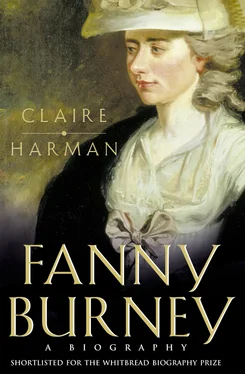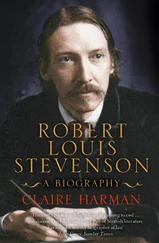In the autumn of 1774 the Burneys were forced to leave Queen Square because of ‘difficulties respecting its title’. 50 The house they moved to was right in the centre of town, on the corner of Long’s Court and St Martin’s Street, which runs south out of Leicester Square. Although the air was not so balmy as in Queen Square, with its ‘beautiful prospect’, and though St Martin’s Street was, in Fanny’s blunt words, ‘dirty, ill built, and vulgarly peopled’, * 51 there were many things to recommend the new address. It was convenient for the opera house and the theatres, the aunts in Covent Garden, Hetty and her young family in Charles Street and many of Dr Burney’s fashionable friends (Sir Joshua Reynolds lived just round the corner in Leicester Square). It also had the distinction of having been Sir Isaac Newton’s house, which alone would have recommended it to the astrophile Burneys. Newton lived there from 1711 to his death in 1727, and built a small wooden observatory right at the top of the property, glazed on three sides and commanding a good view of the city as well as the sky. ‘[W]e shew it to all our Visitors, as our principal Lyon’, Fanny wrote in her journal ten days after moving in.
The Burneys were so proud of the connection with the great scientist that they thought of calling their new home ‘Newton House’ or ‘The Observatory’ as a boast. Charles Burney was particularly fond of dropping Sir Isaac’s name into conversation, and displayed a certain ingenuity at creating occasions to do so. Once when a visitor broke his sword on the stairs Burney protested that they ‘were not of my constructing – they were Sir Isaac Newton’s’; 53 and on Mrs Thrale’s first visit to the house he said he was unable to ‘divine’ the answer to a query about a concert, ‘not having had Time to consult the stars, though in the House of Sir Isaac Newton’. 54 As a sort of homage to their illustrious precursor, Burney spent a considerable sum having the observatory renovated. He did not, however, choose the chilly rooftop perch for his study (a small room adjoining the library on the first floor performed that function much more comfortably), and it was soon colonised by the children, Fanny adopting it as her ‘favorite sitting place, where I can retire to read or write any of my private fancies or vagaries’ – a substitute for her closet or ‘bureau’ of former days.
Of all the Burneys’ homes, number 1 St Martin’s Street is the most famous. * Dr Burney and his wife lived there for thirteen years, by the end of which the children, with the exception of their younger child, Sarah Harriet (born in 1772), had all left home. The house had a basement and three storeys each consisting of a front and back room, with a projecting wing to the rear on each floor. On the ground floor at the front was the panelled parlour where the family took their meals, † and behind it was another parlour (the kitchen, presumably, was in the basement). Above it, up the fine oak staircase, was the drawing room, with three tall windows looking onto St Martin’s Street. This room was the most splendid in the house, and had an ‘amazingly ornamented’ painted ceiling, probably depicting nudes, since it seems to have been something of an embarrassment to the Doctor: ‘I hope you don’t think that I did it?’ he said to one curious visitor, ‘for I swear I did not!’ 56 Sir Isaac’s name was not invoked on this occasion. There had been three other owners since the scientist, one of them French.
The drawing room was separated from the library by folding doors which, when opened, provided a large and elegant space for the many parties and concerts which the Burneys soon began to hold at St Martin’s Street. Dr Burney’s library was extensive and highly specialised: when Samuel Johnson visited for the first time and abandoned the company to inspect the books, he would have found few volumes on any subject other than music (although he still preferred looking into books on music to attending the Burneys’ informal concert which was the alternative entertainment). The library, also known as the music room, had a window looking down onto the small, overshadowed garden at the back and contained the Doctor’s two harpsichords. Beyond it, in the part of the building which projected out at the back, was Burney’s narrow workroom, grandly named ‘Sir Isaak Newton’s Study’ (on hearsay), but commonly known as ‘the Spidery’ or ‘Chaos’ and habitually so untidy with Burney’s sprawl of papers that no guests were invited to look in.
On the top floor at the front was the main bedroom, used by Dr and Mrs Burney, with a powdering closet adjoining. The girls’ bedroom was beyond it at the back, above the library. The three attic rooms, from which one gained entrance to the observatory, were probably servants’ bedrooms and the nursery, with a poky stairway leading from the top floor. James was scarcely ever at home, but still had a room on the ground floor kept for him that opened onto the little garden; Charles junior probably slept there when he was home in the holidays from Charterhouse. Beyond ‘Jem’s room’, opening onto Long’s Court, was a small workshop, which Dr Burney rented to a silversmith. It is likely that the workshop created some noise and smell around the back of the house, a reminder of trade going on only just out of sight and earshot of the elegant drawing room. The back of the workshop and its yard would have been visible though from the girls’ bedroom window and the eastfacing side of the observatory.
The household in the autumn of 1774 consisted of the Doctor and his wife, both approaching fifty, Fanny (who, aged twenty-two, might not have been expected to be at home for much longer), Susan, aged nineteen, thirteen-year-old Charlotte, the lively six-year-old Richard and toddler Sally, then as always a rather neglected little girl. Small children were never going to be a novelty in the Burney household. When the family moved into St Martin’s Street, Esther was only a few weeks away from giving birth to her third child, Charles Crisp Burney, having had Hannah Maria in 1772 and Richard in 1773, the first three of Dr Burney’s eventual total of thirty-six grandchildren.
The move to St Martin’s Street took place while Charles Burney was recuperating from another bout of rheumatic fever. He was confined to bed for weeks, but carried on work on the History by dictating to Fanny and Susan. The family did not hold a large party at the new house until March 1775 on account of this indisposition, but the publication of The Present State of Music in Germany […] in 1773 had significantly increased Burney’s standing as a writer as well as a historian of music, and there was no stopping the flow of illustrious visitors passing through London who wanted an introduction to him. Fanny’s letters to Crisp in 1774 and 1775 contain many highly entertaining set-pieces describing some of these callers. The first was the most exotic, a young native of the Society Islands called Omai who had come to England on board the Adventure with James Burney. James, who had finished his training as an able seaman in 1771, had joined Captain Cook’s second voyage to the Antarctic Circle the following year, returning to England in July 1774. He had mastered some Tahitian on the voyage home and was able to act as interpreter to ‘lyon of lyons’ Omai, who was fêted all round London, received by the King and invited to the houses of aristocrats keen to observe and display a living emblem of the nation’s South Sea discoveries. Omai arrived at the Burneys’ house in the company of Joseph Banks and Daniel Solander, the botanists who had accompanied Cook on his first circumnavigation of the globe. His manners impressed Fanny extremely favourably; even though he had very little English, the Polynesian ‘paid his Compliments with great politeness […] which he has found a method of doing without words ’. 57 Fanny sat next to him at dinner and noticed how unostentatiously alert Omai was to the feelings of others, glossing over the servant’s mistakes and assuring Mrs Burney that the (tough) beef was actually ‘very dood’. He ‘committed not the slightest blunder at Table’, and didn’t fuss over his new suit of Manchester velvet with lace ruffles, although it was totally unlike his native costume (or the fantasy burnous in which he was painted by Reynolds during his visit). ‘Indeed’, wrote Fanny to Crisp, ‘he appears to be a perfectly rational & intelligent man, with an understanding far superiour to the common race of us cultivated gentry: he could not else have borne so well the way of Life into which he is thrown’. With his spotless manners and spotless ruffles, Omai could not have been a more perfect example of Noble Savagery, showing up the gracelessness of the expensively educated ‘Boobys’ around him in a way that the future satirist found highly gratifying. ‘I think this shews’, she concluded grandly, ‘how much more Nature can do without art than art with all her refinement, unassisted by Nature .’ 58
Читать дальше












